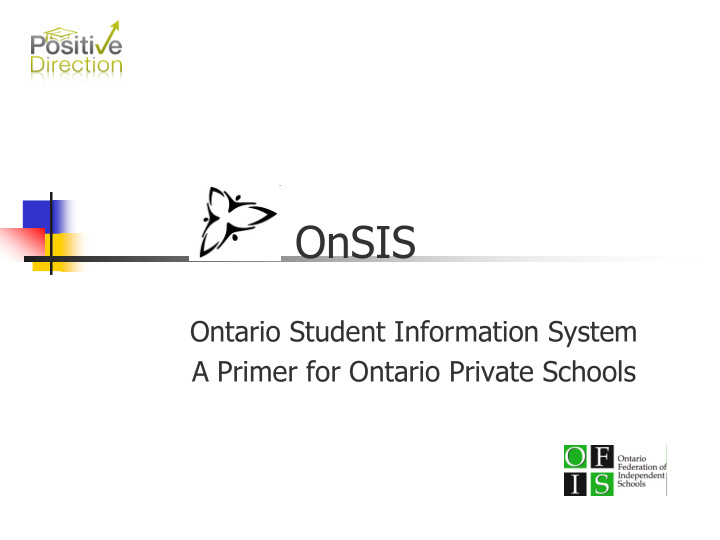



OnSIS Ontario Student Information System A Primer for Ontario Private Schools
What is OnSIS? OnSIS is a Ministry system for the collection and management of education related data whose intent is to provide the Ministry with information to facilitate policy development and business planning, most of which is of course directed at the public sector. OnSIS represents a web-based consolidation of data previously collected through paper based aggregate submissions stored in segregated data bases. Its intent is to provide the Ministry, and eventually schools and school boards, with comprehensive, depersonalized qualitative data for the purpose of developing evidence based analysis of student achievement.
Why Must I Report? OnSIS reporting has been mandatory for all private and independent schools in Ontario who wish to retain their status as Ontario Ministry of Education Inspected schools with the authority to grant credits since the outset of the Managing Information for Student Achievement MISA initiative in 2002; Compliance has been an issue since the beginning, as schools in the private sector, particularly those with limited resources, have not been convinced that the potential benefits of participation outweigh the projected costs; As a result, some schools have opted to ignore the compliance provision with the result that the “private” sector has been under-represented in the data accumulation process.
Consequences of Non-compliance The Ministry has determined that non-compliance undermines the spirit and intent of the data collection process; In 2011, the Ministry determined to tie the ability to submit the NOI to OnSIS reporting; In response to appeals made by OFIS, among others, Schools in delinquency were afforded a grace period to comply with the OnSIS reporting protocol which will expire this summer (2012) when non-compliance will mean inability to file a NOI and consequent removal of “inspected” status for delinquent schools.
Potential Ancillary Benefits of Compliance Access to more accurate statistically based comparative analysis of student achievement in the public and private/independent education sector useful, in association with other measures (EQAO, PCAP) in the establishment of benchmarks for student success within your school; Access to evidence based data to support long-term business and educational planning; Creation of a more efficient more secure and integrated information system; Development and maintenance of a more sophisticated and comprehensive school administrative system.
OnSIS Submission – The Basics OnSIS Reports are required three times a year in October, March and June; Schools may provide data to OnSIS using one of the following methods: On-line, directly from the OnSIS Application Submitting a batch file via the OnSIS Application On paper (for schools without Internet access); Each submission must be separately validated and verified. Schools running summer programs and/or night school programs will be required to make dedicated submissions for each.
OnSIS Security Access to the application is secure and password protected for each user authorized by the school; Each school will determine the level of access granted to individual users; All data collected is depersonalized and stored in the Elementary/Secondary Data Warehouse (ESDW).
The Successful OnSIS Submission Successful OnSIS submissions are the result of careful planning which includes provision for access to appropriate technology, the building of capacity, allocation of economic and human resources and above all else, the input of error free data; Efficient, effective and accurate data reporting is based on: timely, accurate and comprehensive data input; the creation of a “climate of quality data collection and input” which is inclusive and collaborative; The development of effective data collection, retention and retrieval protocols that reflect your schools circumstances.
The Role of the School’s IT and SIS A school’s ability to ensure efficient OnSIS reporting depends on meeting certain minimum IT requirements and the careful construction of their Student Information System; School’s must work to build capacity, adopt a Student Information System that accommodates OnSIS, and in the development of a relatively seamless interface between the two.
Report Generation and Error Messages The report generation function of the OnSIS application is the means by which users of the system are able to access the aggregate information supplied by their school to the Ministry of Education; Each report is drawn from the data entered by the school and because data must be verified and validated at source, the number and type of error message generated is a function of the accuracy with which the data is entered; Familiarity with the structure and data entry requirements of the OnSIS application is therefore paramount. Time and care exercised here will reduce the number of error messages substantially.
Types of Error Messages No matter how careful you are with the data entry portion of your submission, you will get error messages. Most of them can be resolved with a few “tweaks” to your data as they will generally originate with only a few entries. Critical Error messages must be resolved before verification and validation Warnings are an indication that there are anomalies in your data set that you should be aware of but you are not obligated to correct
Positive Direction can assist you to: interpret OnSIS requirements, develop data quality management strategies, and co-ordinate school OnSIS submissions; review data quality, validity, inter-reliability, and collection, retention, retrieval and reporting methodologies; trouble shoot and resolve OnSIS error messages by locating and correcting data entry errors; develop and manage ongoing, customized OnSIS training and support for your school.
Questions and Answers You are invited to ask questions which I will do my best to answer. Thank you for your attendance.
More recommend